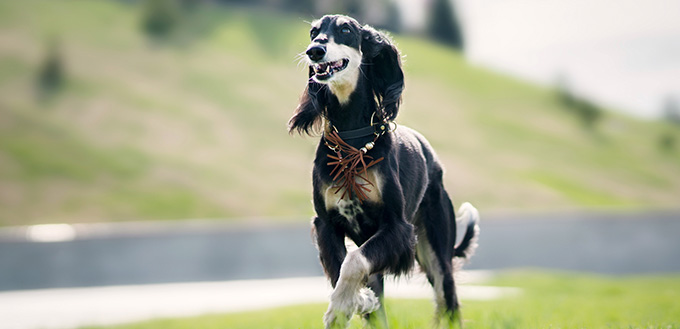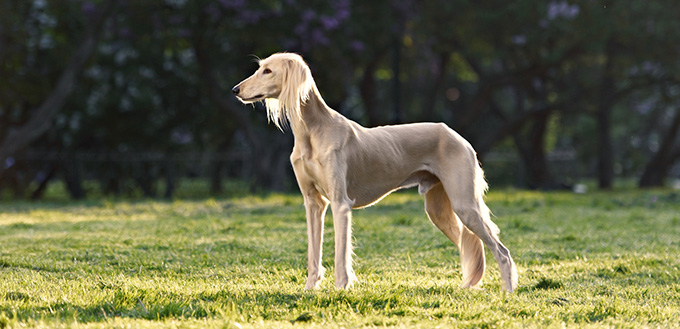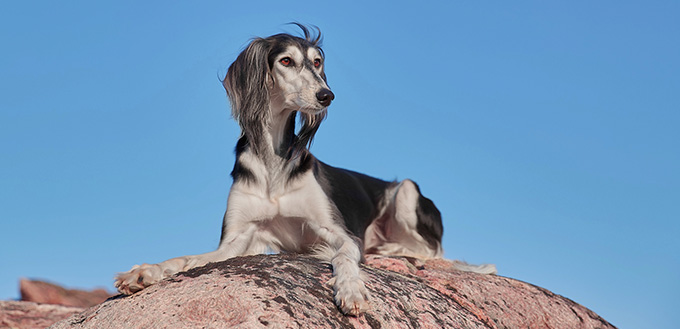Every breed of dog is accompanied by its unique features, and the Saluki dog breed is not an exception. This dog has a slender figure, with a deep chest and long legs. It has a long and narrow head with the ears dropping down from it, as well as a long, curved tail. The Saluki colors vary and include a white Saluki, red, cream, fawn, or a mixture of white, tan, and black. This breed has a graceful and symmetric look, with a fluffy, feathery coat, especially around their thighs, legs, and sometimes throat. Some variations of the breed exist, but in this article, the general characteristics of the breed will be looked at.

History of the Saluki
The breed’s ancestry has been linked to those bred in the area where agriculture originated, called the Fertile Crescent. Dogs similar to Salukis have been seen on wall carvings of what is now Iran since the 6,000 to 7,000 BCE. The Saluki-like dogs, however, only gained popularity and importance during the eighteenth dynasty of Egypt. The skeletons of a dog with body measurements close to the Saluki were found in modern Syria and dated at about 4,000 years old. Other mummified bodies were also found buried with Pharaohs. Before today, a lot of art, including poetry, paintings, book illustrations, as well as outstanding pieces of sculpture. There are tales of crusaders bring the dogs from the Middle East, with depictions of dogs wearing collars of Pilgrim owners as evidence. During the 1930s, the king of Bahrain was famous for his pack of Saluki hounds that followed him on his hunts in the Arab world. Two of his purebreds were saved and later registered with the Kennel Club of Bahrain after the other dogs were mixed with other breeds. This breed was and still is held in high esteem as superiors when it comes to hunting. They were also the only breed that was allowed to reside in the family tent of Muslims who considered dogs to be unclean. They were also allowed around women while other breeds were not.
Salukis were brought into England in 1840 and were treated the same as the Sloughi, but the two were later proven to be different. 1985 was the year that the breed was successfully reproduced by Florence Amherst, who imported a pair from a part of lower Egypt. She struggled for about thirty years before the breed started becoming famous in the 1920s. This was after world war I, where the officers brought their pet Salukis back with them from the Middle East into Europe. Florence collaborated with one officer Lance to further promote this breed of dog until it became very popular around the world.
Quick Facts About the Saluki
- They are sighthounds: Salukis are one of those dog breeds that use their sight for hunting rather than their smell or sound. They have a very sharp vision that allows them to spot and keep the prey in view. This exceptional vision, in addition to their agility and speed, is what earned them in the first place as superior hunters. Their long slender head also adds to the excellent vision by giving them a full range. They are mostly bred in open grasslands void of vegetation, which may obstruct their view.
- They are reserved: Salukis are very independent dogs because of some of their features that make it difficult for others to catch up to them. This independence turns into reservedness and sometimes timidity. They will not make friends immediately and will have to be socialized at a young age to help them integrate better in their environment. This independence and timidity make it challenging to train them since you will need a lot of patience and gentleness. Also, even though they are considered suitable for apartment living. They should not be left unsupervised for a long time.
- They are royalty: Salukis are known to have their ancestry linked to the Middle East, where they were known to be buried alongside the Pharaohs. The high in Egyptian society considered this breed to be valuable and honorable hence their mummification in resemblance to that of kings. The Arabs considered them as gifts from God and gave them equal attention as their horses, and were very impressed with their speed and endurance.
- Their appearance is not a reflection of their physical ability: Salukis are very fast: their slender build makes it easy for them to glide through the wind. Their feet are padded, making them better at absorbing shock. They run faster and longer than any other breed there is and can run up to 42 miles per hour. It is no wonder that they were used for hunting gazelles. With a little henna or nut oil on their feet, they were protected from injury or hardening. On the outside, they look elegant and fragile with their soft coat and luxurious hair. But once this dog takes off, you will be surprised at how much strength it displays.

Things You Should Know
Training
The Saluki has the kind of intelligence that makes it know how to open a refrigerator door without any help. You would think that a dog like this would not need any form of training but on the contrary. They will need to learn a few things, but the only difference will be the method or approach and the type of training involved. When teaching this breed, keep in mind that it is not like any other typical dog and so you’d have to be more attentive to their tricks. Since this breed likes to think of itself as a human, you’ll need to be firm to establish that you are the boss of the relationship. They might be reluctant at first if they feel the training will not benefit them. Even though you should be authoritative, you also have to be patient and gentle with the dog. Try to understand them and create a calm, enabling environment in which they can learn. Since they are smart, they can quickly become bored if training sessions are too long or irregular.
Make sure that training sessions are straight to the point and consistent to get the best results. In terms of who to train this breed, they will learn better if the trainer is someone they already know. Salukis can be shy and reserved towards people they do not know and might not take the training seriously. Training might only help your dog be obedient most of the time, but not all the time because of their independent nature. You can start with the Saluki puppy so that it grows into becoming more obedient since it can be challenging to teach an old dog new tricks. Always make sure the dog is on a leash because you cannot catch up with it if it does.
Feeding
Obesity is not a problem for Salukis since they are active animals. Their diet should consist of a balance of carbohydrates, fats, and protein, with animal protein, with protein making the majority. Their diet should contain safe ingredients fortified with these nutrients as well as Omega-3 and Omega-6 fatty acids to guarantee their healthy growth. You can feed them high-quality dry dog food at least once a day. You can also give them kibble throughout the day, without worrying about their becoming overweight.
Grooming
The external of the dog is as important as the inside, and you should take it pretty seriously. Grooming involves keeping the dog clean from head to paws through processes like brushing their teeth and hair, clipping nails, bathing, and cleaning their ears. There are feathered Saluki on their ears and behind their legs, while others aren’t, and both the long-haired Saluki and otherwise have smooth coats. They will need to be brushed at least once a week, using a soft bristle brush. Start from the head and brush gently in the direction of hair growth to prevent hurting the dog. Be very gentle around delicate areas, and you can add oil too for extra shine. This breed, however, is hygienic, and they keep their coats well so your effort will be minimized. You can bathe the dog when it is visibly dirty or smelly using dog shampoo and a clean towel. Nail trimming can be tricky, and you should know what you are doing before going in. You can ask a professional to teach you a safe and easy technique, as well as the right tools to use. With regards to brushing their teeth, the same principles apply.
You may also like our guides on Dog Toothbrush, Dog Toothpaste, Bath Tubs for Dogs, Dog Shedding Brush, and Dog Conditioners.
Health
Every living organism will suffer one or two illnesses in their lifetime, and the Saluki breed is not any different. They can live for about 12 to 14 years, with the adult dog weighing about 18 to 27 kilograms. Because they are natural hunters, they need to be in shape at all times. Exercising is suitable for their health to keep them at an appropriate weight and also active. One health issue that rarely occurs in Salukis is hip dysplasia, which is an abnormal formation of the hip socket. The dog’s agility requires that its joints are in good shape, and so this breed scores the lowest for this illness. One of the primary agents of death in the breed, however, is cancer, with liver cancer or lymphoma being the most common. This affects the liver and lymph nodes, respectively, disrupting their normal function and forms 35.6% of deaths. Another cause of death that is not as common in Salukis as the earlier mentioned is cardiac-related issues. Saluki dogs suffer from heart failure and other heart defects, which make the second leading cause of fatalities in these dogs. Aside from these they may also experience cardiomyopathy, which is a set of diseases that deteriorate the heart muscles. They also experience heart murmurs, which are the very loud sound of blood pumping across valves. The third major cause of death in Salukis is old age, which is typical for most organisms.

Temperament
Salukis are brilliant animals, and you would need to be at least as smart as them to exert dominance or get them to obey you. Because of their superior qualities, they feel like they are in a league of their own and do not need to succumb to any other authority. That independence may come with reservedness especially to strangers. This Saluki temperament reflects in their training, and it may become challenging for the trainer. The reservedness makes them show no excitement about new people, and Saluki puppies can be very calm and gentle adults. They cannot be trusted off a leash and should not be left unsupervised for long. They quickly get bored, and so entertaining them is difficult. They are not typically aggressive dogs and do not indulge in much play, but they will settle down to play with a soft toy. Due to their hunting prowess, a moving object like a bird, cat, or squirrel will catch its attention. It is very likely to chase after them, and if you are not careful, things might get out of hand. Having a fence will be an advantage for you to keep the dog in check.
To Summarize
The variety in dog breeds increases the chances of every person getting a match. If you are a strong-willed authoritative person who can be patient and gentle, then the Saluki hound will work for you. This ancient dog is considered royalty, with its sleek look and prominent features, which give it an upper hand when it comes to physical activity. This dog has a mind of its own, and so you need to be firm whenever you are teaching them new tricks. To make it easier, start when they are young so that it sticks with them throughout their life. At any point, if you need more information about this breed with regards to taking care of it, consult a veterinarian to help.
Source:
- Saluki, VetStreet







